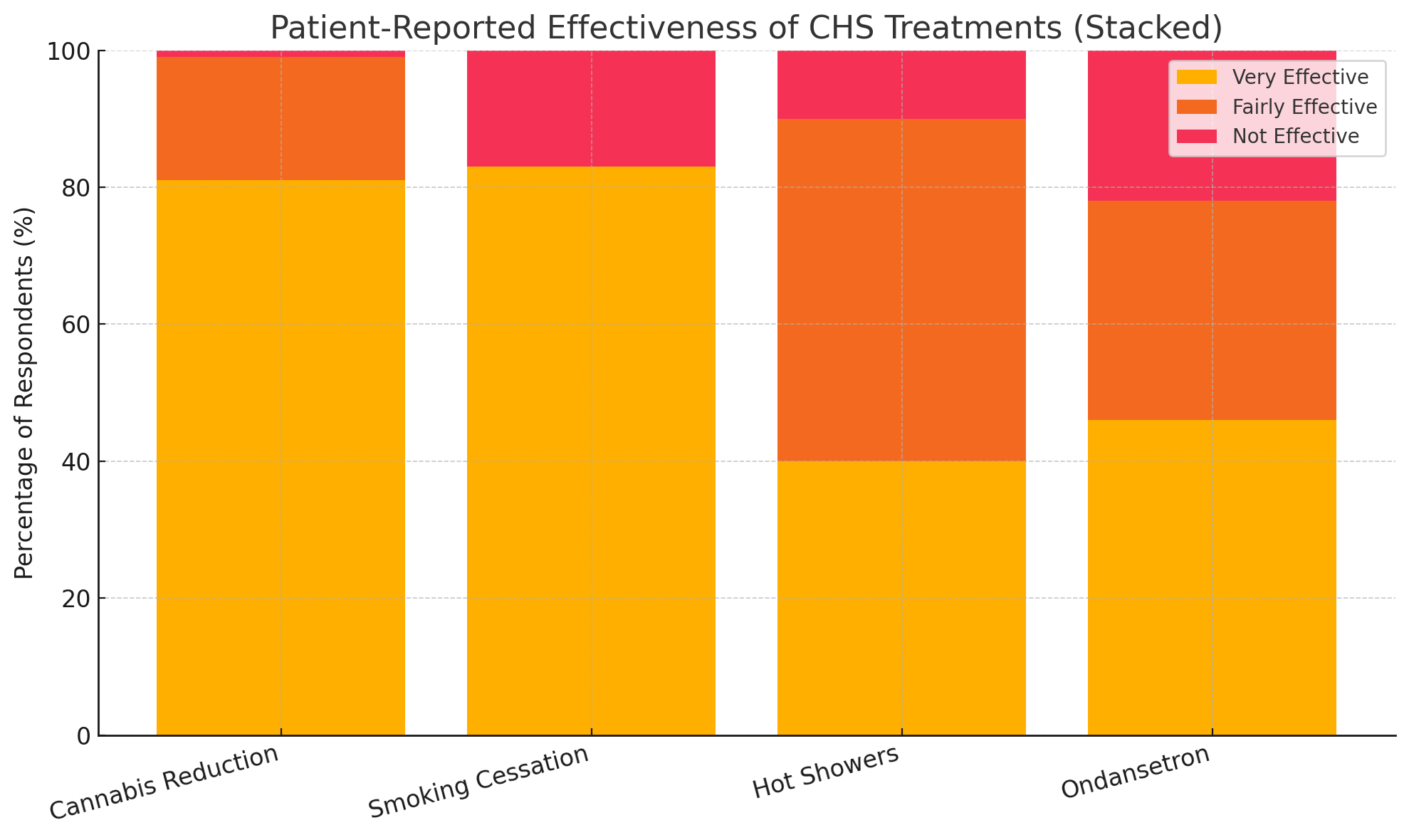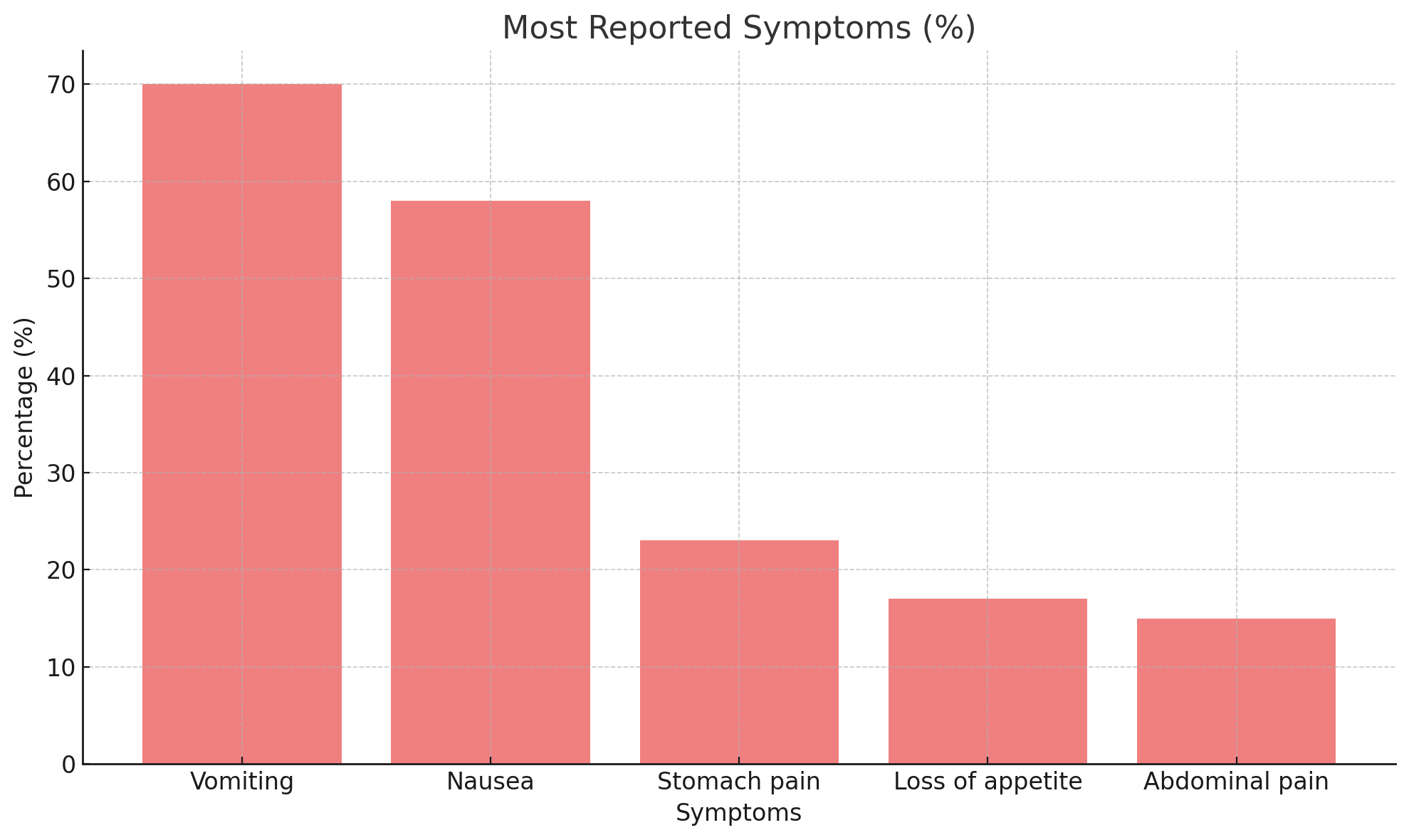Tuesday Poster Session
Category: Functional Bowel Disease
P5072 - Real-World Treatment Patterns and Patient-Perceived Effectiveness in Cannabinoid Hyperemesis Syndrome: A Survey of 829 Individuals
Tuesday, October 28, 2025
10:30 AM - 4:00 PM PDT
Location: Exhibit Hall

Dimo Dimitrov, MD
St. Elizabeth's Medical Center, Boston University School of Medicine
Boston, MA
Presenting Author(s)
Dimo Dimitrov, MD1, Sushrut Jangi, MD2
1St. Elizabeth's Medical Center, Boston University School of Medicine, Boston, MA; 2Tufts Medical Center, Boston, MA
Introduction: Cannabinoid hyperemesis syndrome (CHS) is an increasingly recognized condition characterized by recurrent nausea and vomiting in chronic cannabis users. Despite its growing prevalence, data on treatment effectiveness remain limited and are largely derived from small case series.
Methods: We analyzed self-reported data from 829 individuals with CHS using the crowdsourced health platform StuffThatWorks, which collects structured patient-reported data on symptoms and treatment effectiveness across medical conditions. Of these, 459 provided treatment effectiveness ratings for the four most commonly reported interventions: cannabis reduction, hot showers, smoking cessation, and ondansetron. Respondents rated each treatment as “very effective,” “fairly effective,” or “not effective.” Chi-square testing with Bonferroni-adjusted post-hoc comparisons was used to assess differences in perceived treatment effectiveness among these four interventions.
Results: Vomiting (70%) and nausea (58%) were the most frequently reported symptoms. Among the four most commonly reported interventions, cannabis reduction and smoking cessation were rated as “very effective” by 81% and 83% of respondents, respectively. Hot showers and ondansetron received more mixed ratings, with only 40% and 46% reporting them as “very effective.” Chi-square analysis revealed significant differences in effectiveness among all four treatments (χ²(6, N = 459) = 90.86; p < 0.001). Pairwise post-hoc analysis with Bonferroni adjustment indicated statistically significant differences between all pairs of treatments (all p-values < 0.0083). Among 22 individuals who continued cannabis use as a form of symptom relief, none reported benefit, and 18% experienced symptom worsening.
Discussion: In this large patient-reported study, cannabis reduction and smoking cessation were significantly more effective for CHS symptom relief than symptomatic treatments such as hot showers and ondansetron. These findings align with CHS pathophysiology and underscore the critical role of clinician-led cessation counseling and patient education. Given high relapse rates and misconceptions about cannabis's antiemetic role, patient education and structured follow-up are critical for sustained recovery. Limitations include reliance on self-reported data and potential selection bias. Future research should focus on controlled trials and targeted educational initiatives to improve CHS recognition, reduce misdiagnosis, and alleviate healthcare burden.

Figure: Stacked bar chart showing the proportion of respondents rating cannabis reduction, smoking cessation, hot showers, and ondansetron as “very effective,” “fairly effective,” or “not effective.”

Figure: Bar chart displaying the percentage of respondents reporting each symptom. Vomiting and nausea were the most commonly reported.
Disclosures:
Dimo Dimitrov indicated no relevant financial relationships.
Sushrut Jangi indicated no relevant financial relationships.
Dimo Dimitrov, MD1, Sushrut Jangi, MD2. P5072 - Real-World Treatment Patterns and Patient-Perceived Effectiveness in Cannabinoid Hyperemesis Syndrome: A Survey of 829 Individuals, ACG 2025 Annual Scientific Meeting Abstracts. Phoenix, AZ: American College of Gastroenterology.
1St. Elizabeth's Medical Center, Boston University School of Medicine, Boston, MA; 2Tufts Medical Center, Boston, MA
Introduction: Cannabinoid hyperemesis syndrome (CHS) is an increasingly recognized condition characterized by recurrent nausea and vomiting in chronic cannabis users. Despite its growing prevalence, data on treatment effectiveness remain limited and are largely derived from small case series.
Methods: We analyzed self-reported data from 829 individuals with CHS using the crowdsourced health platform StuffThatWorks, which collects structured patient-reported data on symptoms and treatment effectiveness across medical conditions. Of these, 459 provided treatment effectiveness ratings for the four most commonly reported interventions: cannabis reduction, hot showers, smoking cessation, and ondansetron. Respondents rated each treatment as “very effective,” “fairly effective,” or “not effective.” Chi-square testing with Bonferroni-adjusted post-hoc comparisons was used to assess differences in perceived treatment effectiveness among these four interventions.
Results: Vomiting (70%) and nausea (58%) were the most frequently reported symptoms. Among the four most commonly reported interventions, cannabis reduction and smoking cessation were rated as “very effective” by 81% and 83% of respondents, respectively. Hot showers and ondansetron received more mixed ratings, with only 40% and 46% reporting them as “very effective.” Chi-square analysis revealed significant differences in effectiveness among all four treatments (χ²(6, N = 459) = 90.86; p < 0.001). Pairwise post-hoc analysis with Bonferroni adjustment indicated statistically significant differences between all pairs of treatments (all p-values < 0.0083). Among 22 individuals who continued cannabis use as a form of symptom relief, none reported benefit, and 18% experienced symptom worsening.
Discussion: In this large patient-reported study, cannabis reduction and smoking cessation were significantly more effective for CHS symptom relief than symptomatic treatments such as hot showers and ondansetron. These findings align with CHS pathophysiology and underscore the critical role of clinician-led cessation counseling and patient education. Given high relapse rates and misconceptions about cannabis's antiemetic role, patient education and structured follow-up are critical for sustained recovery. Limitations include reliance on self-reported data and potential selection bias. Future research should focus on controlled trials and targeted educational initiatives to improve CHS recognition, reduce misdiagnosis, and alleviate healthcare burden.

Figure: Stacked bar chart showing the proportion of respondents rating cannabis reduction, smoking cessation, hot showers, and ondansetron as “very effective,” “fairly effective,” or “not effective.”

Figure: Bar chart displaying the percentage of respondents reporting each symptom. Vomiting and nausea were the most commonly reported.
Disclosures:
Dimo Dimitrov indicated no relevant financial relationships.
Sushrut Jangi indicated no relevant financial relationships.
Dimo Dimitrov, MD1, Sushrut Jangi, MD2. P5072 - Real-World Treatment Patterns and Patient-Perceived Effectiveness in Cannabinoid Hyperemesis Syndrome: A Survey of 829 Individuals, ACG 2025 Annual Scientific Meeting Abstracts. Phoenix, AZ: American College of Gastroenterology.
